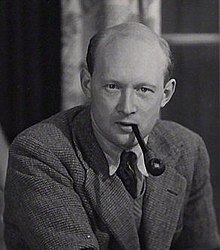Our website is made possible by displaying online advertisements to our visitors.
Please consider supporting us by disabling your ad blocker.
C. H. Waddington
This article has multiple issues. Please help improve it or discuss these issues on the talk page. (Learn how and when to remove these messages)
|
Conrad Hal Waddington | |
|---|---|
 Conrad Hal Waddington in 1934 | |
| Born | 8 November 1905 Evesham, Worcestershire, England |
| Died | 26 September 1975 (aged 69) Edinburgh, Scotland |
| Alma mater | University of Cambridge |
| Known for | Epigenetic landscape, canalisation, genetic assimilation, creode |
| Spouse | Justin Blanco White |
| Children | 3, including Caroline Humphrey and Dusa McDuff |
| Awards | Mendel Medal (1960) |
| Scientific career | |
| Fields | Developmental biology, genetics, paleontology |
| Institutions | University of Edinburgh University of Cambridge, Christ's College Wesleyan University Centre for Human Ecology |
| Doctoral students | Robert Edwards |
Conrad Hal Waddington CBE FRS FRSE (8 November 1905 – 26 September 1975) was a British developmental biologist, paleontologist, geneticist, embryologist and philosopher who laid the foundations for systems biology, epigenetics, and evolutionary developmental biology.
His theory of genetic assimilation probably has a Darwinian explanation, which contrast with the fact that Waddington himself was very critic about the notion of natural selection and NeoDarwinism[1]. Leading evolutionary biologists including Theodosius Dobzhansky and Ernst Mayr considered that Waddington was using genetic assimilation to support so-called Lamarckian inheritance, the acquisition of inherited characteristics through the effects of the environment during an organism's lifetime.
Waddington had wide interests that included poetry and painting, as well as left-wing political leanings. In his book The Scientific Attitude (1941), he touched on political topics such as central planning, and praised Marxism as a "profound scientific philosophy".[2]
- ^ Wilkins, AS (2008). "Waddington's unfinished critique of neo-Darwinian genetics: then and now". Biological Theory. 3: 224–232 – via Springer Nature.
- ^ Waddington, C. H. (1948). The Scientific Attitude (2nd ed.). Pelican Books. p. 104 – via Internet Archive.
Previous Page Next Page


